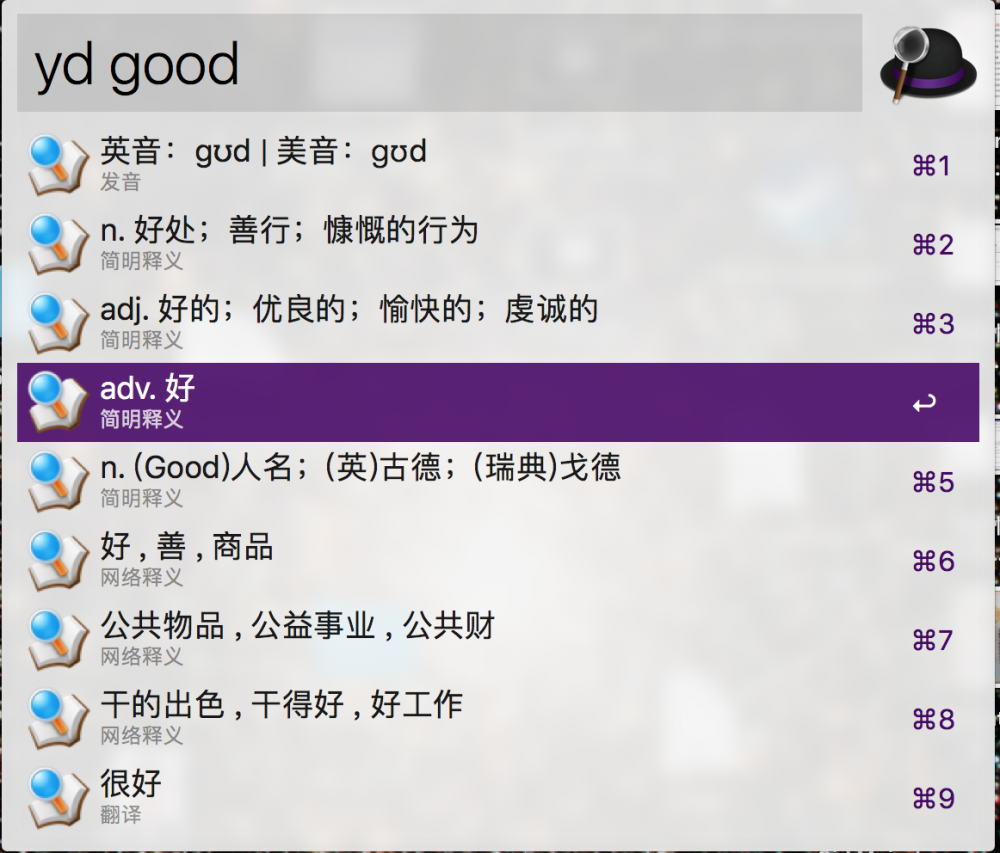撸码的福音--变量名生成器的实现
最近换工作以后,结结实实的写了几个月的业务。需求完结以后,就找找自己喜欢的东西写写,换个口味。
撸码最难的就是给变量取名字了。所以就写一个变量生成器吧。
演示如下:
实现思路:
使用了 Mac 上最出名的效率工具 Alfred 。利用 Alfred 调用本地的 python 脚本,利用 http 模块,请求远程的 API 接口。
远程 API 获取查询的字符后,首先使用 结巴分词 ,对查询的句子进行分词,然后调用有道词典的 API 翻译,拼接以后返回。
最终,一个回车就能把结果输入到我们的 IDE 里面减少很多操作,妈妈再也不会担心我取不出变量名啦。
API 的实现:
既然说换个口味,那 API 我肯定不会使用 ‘Spring mvc’ 啦。
主要采用的是 ‘vertx’ 这个基于’netty’ 的全异步的 java 库。有兴趣的同学可以参考 http://vartx.io 。
使用 Spring boot 管理对象的生命周期。
使用 “结巴分词” 对查询的语句进行分词。
使用 guava cache 来对查询结果进行缓存。为啥要缓存?主要是有道的翻译API是收费的,查完把结果缓存起来能节约一点算一点。
至于为什么使用本地缓存而不是 Redis?因为阿里云的 Redis 一个月要25块钱啊。自己搭一个?我的vps 一共只有 1G 内存啊。
说到底,架构设计需要考虑实际情况,一味上高大上的技术也不可取。适合的才是最好的。
vertx-web
写过 netty 的同学就知道, netty 的业务逻辑是写在一个个的 handler 中的。
同样 vertx 也类似于 netty 也是使用 handler 来处理请求。
vertx 通过 Router 这个类,将请求路由到不同的 Handler 中。所以我们直接看代码:
@Component
public class StaticServer extends AbstractVerticle {
@Autowired
private VariableHandler variableHandler;
@Override
public void start() throws Exception {
Router router = Router.router(vertx);
router.route().handler(BodyHandler.create());
router.post("/api/hump").handler(routingContext ->variableHandler.get(routingContext));
vertx.createHttpServer().requestHandler(router::accept).listen(8080);
}
}
我们把 VariableHandler 绑定到了 ’/api/hump‘ 这个 uri 的 post 方法上了。服务器启动以后会监听 ’8080‘ 端口。 vertx-web的运行是不需要类似 tomcat 这样的容器的。
RestTemplate
我们一般是用 Httpclient 在代码中调用 http 接口。但是我觉得 HTTPClient 封装的不是很好。我们可以直接使用 Spring boot web 提供的 RestTemplate (真香)。直接看代码:
private ApiResponse requestYoudao(String param){
long timeMillis = System.currentTimeMillis();
String salt = String.valueOf(timeMillis);
String sign = Md5Utils.md5(appKey + param + salt + secretKey);
MultiValueMap<String,String> bodyMap = new LinkedMultiValueMap<>();
bodyMap.add("q",param);
bodyMap.add("from","auto");
bodyMap.add("to","auto");
bodyMap.add("appKey",appKey);
bodyMap.add("salt",salt);
bodyMap.add("sign",sign);
MultiValueMap<String,String> headersMap = new LinkedMultiValueMap<>();
HttpEntity<MultiValueMap<String, String>> requestEntity = new HttpEntity<>(bodyMap, headersMap);
return restTemplate.postForObject(url, requestEntity,ApiResponse.class);
}
Guava
Guava 是 google 提供的一个java 基础库类,如果会使用 Guava 的话,会成倍的提升你的开发效率。在本项目中主要使用 Guava 提供的本地缓存和字符串操作:
Guava cache 的使用很简单直接看代码:
@Autowired
private Cache<String,ApiResponse> cache;
private ApiResponse cachedResponse(String param){
try {
return cache.get(param, () -> requestYoudao(param));
}catch (Exception e){
log.error("error",e);
}
return null;
}
Guava 对提供了很多给力的字符串的操作。尤其是对字符串下划线,大小写,驼峰形式,提供的强有力的支持。这样使得我们的 API 提供各种风格的变量形式。我们直接看代:
switch (status){
case Constants.LOWER_CAMEL:
return CaseFormat.LOWER_UNDERSCORE.to(CaseFormat.LOWER_CAMEL,underline);
case Constants.LOWER_HYPHEN:
return CaseFormat.LOWER_UNDERSCORE.to(CaseFormat.LOWER_HYPHEN,underline);
case Constants.LOWER_UNDERSCORE:
return CaseFormat.LOWER_UNDERSCORE.to(CaseFormat.LOWER_UNDERSCORE,underline);
case Constants.UPPER_CAMEL:
return CaseFormat.LOWER_UNDERSCORE.to(CaseFormat.UPPER_CAMEL,underline);
case Constants.UPPER_UNDERSCORE:
return CaseFormat.LOWER_UNDERSCORE.to(CaseFormat.UPPER_UNDERSCORE,underline);
default:
return CaseFormat.LOWER_UNDERSCORE.to(CaseFormat.LOWER_CAMEL,underline);
}
以上就是 API 接口的实现。
python 脚本
本地的python 脚本就极其简单了:
# -*- coding:utf-8 -*-
import httplib,urllib,json
url = 'xilidou.com'
def query(q,status=0):
response = get(q,status)
dates = json.loads(response.read())
items = list()
for date in dates:
item = {}
item['title'] = date.encode('utf-8')
item['arg'] = date.encode('utf-8')
item['subtitle'] = '回车复制'
item['icon'] = getIcon()
items.append(item)
jsonBean = {}
jsonBean['items'] = items
json_str = json.dumps(jsonBean)
if json_str:
print json_str
return str
def get(q,status=0):
parameters= dict()
parameters['q'] = q
parameters['status'] = status
parameters = urllib.urlencode(parameters)
headers = {"Content-type": "application/x-www-form-urlencoded"}
conn = httplib.HTTPSConnection(url)
conn.request('POST','/api/hump',parameters,headers)
response = conn.getresponse()
return response
def getIcon():
icon = {}
icon['path'] = 'icon.png'
return icon
if __name__ == '__main__':
query('中文')
干两件事情:
- 从 Alfred 中获取用户输入的待查询字符串。
- 调用远程的 API 接口获取返回后格式化然后打印结果。
Alfred
大家可以直接下载 github 代码。在 python 文件夹里面找到 hump.alfredworkflow 双击。就安装到你的 Mac 上了。
前提是你的 Mac 安装了 aflred 且付费成为高级用户。
最后
老规矩 github 地址: https://github.com/diaozxin007/HumpApi
workflow 下载地址: 下载
我之前还开发了一个利用 alfred 直接查询有道词典的 workflow。效果如下图:

下载地址如下: https://www.xilidou.com/2017/10/24/%E6%9C%89%E9%81%93-Alfred-Workflow-%E5%A8%81%E5%8A%9B%E5%8A%A0%E5%BC%BA%E7%89%88/。
欢迎关注我的微信公众号:

- 本文标签: 代码 开发 spring python js Spring Boot 管理 key src 翻译 bean map GitHub 阿里云 vps 生命 https id IDE json lib 服务器 constant cat Google REST 云 http git IO redis App client web 微信公众号 tar Netty 缓存 list core tomcat cache UI 需求 Connection java 下载 架构设计 API value entity 端口 ORM 安装
- 版权声明: 本文为互联网转载文章,出处已在文章中说明(部分除外)。如果侵权,请联系本站长删除,谢谢。
- 本文海报: 生成海报一 生成海报二











![[HBLOG]公众号](https://www.liuhaihua.cn/img/qrcode_gzh.jpg)

